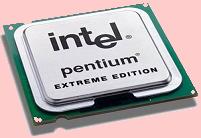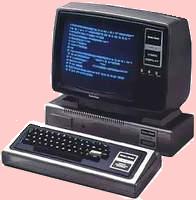NOT BAD FOR A SNAIL (31 january 2008)
If you want to find out how fast a computer is, one important factor will be its clock speed. For instance, a fast Pentium 4 computer has a clock speed of about 3 gigaHerz -- three billion (3,000,000,000) oscillations per second.

When the first personal computers appeared on the market, they were much slower than today's speed monsters. My first computer, for instance, was Tandy's TRS80. It had been introduced in 1977 -- the very same year that the first chess computer saw the light of day. The TRS80 worked at a speed of 1.77 MHz, which is 1.77 million oscillations per second. This may sound like quite a lot, but is a mere 0.06 percent of the speed of the Pentium 4 mentioned above.
Recently, the Overtom Chess Computer Museum acquired a very unusual chess computer, which consisted of a card that could be slid (or slided?) into an electronic organizer.
You can see the card in the lid of the organizer (in the picture above: on the right).
This is what the card itself looks like:
What would the speed of this computer be?
Well, I won't keep you in suspense for too long. Its clock speed is only 32,768 Herz (oscillations per second), which -- I admit -- could be called fast if you had to shake your arms or legs at that speed. But believe me: for a computer it is snail's pace -- less than two percent of the speed of the old TRS80. Or less than 1/60 of the speed of the first chess computer.
I suppose the makers opted for such a low speed to save batteries. After all, not many people will want an organizer that operates at a breathtaking speed but whose batteries have to be replaced every few hours.
When a new chess computer enters the Overtom Collection, it first has to play at least one game against Fritz-one-ply. I can imagine you'll want to know how this snail played:
White: Fritz 8 (1 ply)
Black: Organizer Chess IQ-718M (± 10 sec. / move)
Een animatie van deze partij is te zien als u Java op de computer heeft.
"Bah, black loses," you may say. But be fair: Fritz's speciality is the king's side attack, in which it is probably greatly assisted by its huge hash-tables. The organizer's first fifteen moves were not played too badly.
I allowed the card to play a few more games against shackled Fritz -- as fellow-collector Mike Watters once called Frans Morsch's strong program set at one-ply.
One game went like this:
White: Fritz 8 (1 ply)
Black: Sharp IQ-718M (± 10 sec. / move)
Een animatie van deze partij is te zien als u Java op de computer heeft.
Well, I don't know what you think about this, but I'm pretty amazed about a victory gained by such a slow computer!
